Low FODMAP Grits are versatile! Savory or sweet, we enjoy them for breakfast as well as at dinner. Corn can be a confusing ingredient in the world of the low FODMAP diet, as it comes in so many different presentations from fresh to dried (like popcorn), and then when it comes to cornmeal there are several kinds as well. Let’s get into grits from a FODMAP perspective.
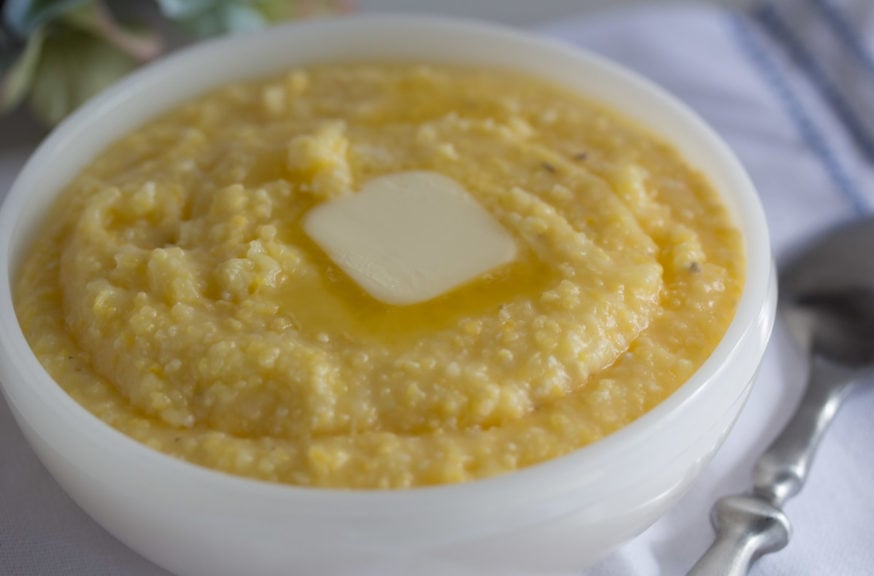
The Many Faces of Cornmeal
Cornmeal comes in a variety of textures. For cornbread we use a fine grind. For grits or polenta we use coarser grinds. (Please note that we did not develop the recipe with grits made from hominy; some grits are made from hominy, some from cornmeal. PS: canned hominy has been lab tested by Monash University and dried hominy has not as of yet.)
Shopping for cornmeal can be confusing as every manufacturer seems to use a different term when it comes to what they think is fine/medium/coarse grind, and whether they attach any other descriptive words.
One company’s polenta is another’s grits and yet another will just say coarse cornmeal. Best to look at the texture before you buy, if you can. No matter what they are called, we do prefer stone-ground.
Two Main Ingredients – Cornmeal and Liquid of Choice!
Grits are simply cornmeal simmered with milk or water and they can be enjoyed for breakfast, lunch or dinner. Some sort of savory seasoning is typical – from simple salt and pepper to the addition of cheese, as in Cheesy Grits – or a nice pat of butter.
For breakfast we have been known to drizzle maple syrup on top and a crumble of bacon to go along with a fried egg.
Patience is Definitely a Virtue!
Any which way you have to make up a batch of the basic grits and it couldn’t be easier. You just need a heavy bottomed pot and patience. Some folks like milk, others water, and yet another contingent likes a combo. It’s your choice, just make sure your milk is lactose free if you go that route.
Just stick with the amount of liquid in proportion with the cornmeal. And of course, those made entirely or partially with milk will be richer. We find milk isn’t always necessary but your taste buds will tell.
This batch makes a lot but there are recommendations below in Tips to help you with any leftovers. You like ours fried the next day! Or alongside a Pork Ragu!
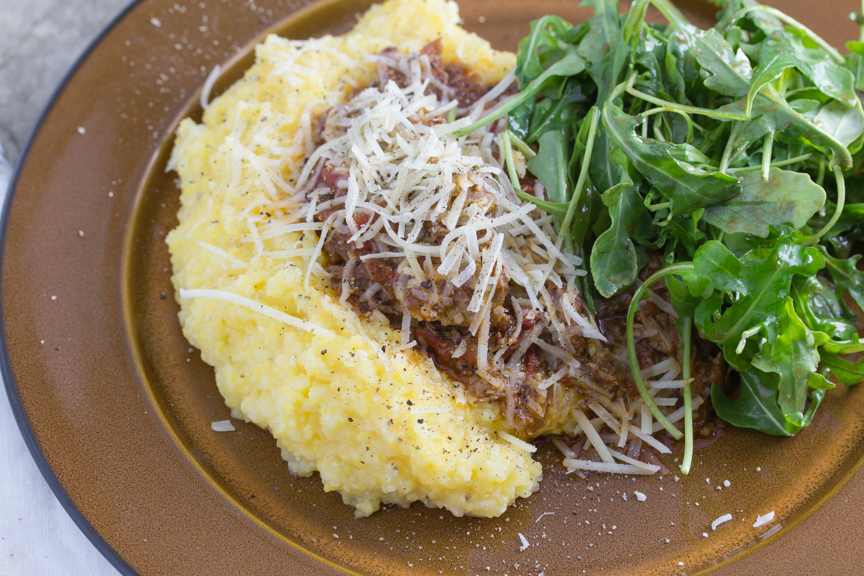
You can find some of our favorite varieties of cornmeal grits in our Shop.
FODMAP Information
All recipes are based upon Monash University & FODMAP Friendly science at time of initial publication.
- Butter: Both Monash University and FODMAP Friendly have lab tested butter. Monash states that a low FODMAP Green Light portion is 1 tablespoon or 19 g and also states that “butter is high in fat and does not contain carbohydrates (FODMAPs)”. FODMAP Friendly gives it a “Pass” at 1 tablespoon or 19 g. Both recommended serving sizes are presented as part of healthy eating guidelines, not as maximum FODMAP serving size. Fat can affect guy motility and trigger IBS symptoms in some people. Eat to your tolerance.
- Cornmeal: Monash University has lab tested cornmeal, which they list as “Polenta (cornmeal)” and a low FODMAP serving size is 255 g, but that is for cooked. They also have a listing for “Flour, corn (masa harina/masa lista)”, and that low FODMAP serving size is 100 g. Masa harina is cornmeal that is treated with lime (calcium hydroxide), a process called nixtamalization. In personal conversations with Monash, we were told that “regular” cornmeal would be the same as the masa, FODMAP-wise, and that the process of using the lime alkaline solution would not affect FODMAPs.
- Lactose-Free Dairy: Lactose-free dairy, such as lactose-free milk or lactose-free cream cheese, has lactase enzyme added that breaks the disaccharide molecules and creates a more digestible dairy product, from a lactose perspective. The resulting product is not dairy-free, but it is lactose-free. Some products might have miniscule amounts of lactose remaining, but the amount is small enough for the product to be labeled as lactose-free. For instance, Breyers Lactose-Free Vanilla Ice Cream states it is 99% lactose-free, while Lactaid Vanilla Ice Cream states it is 100% lactose-free.
Please always refer to the Monash University & FODMAP Friendly smartphone apps for the most up-to-date lab tested information. Foods will be retested from time to time; in the case of raw ingredients, such as fruits and vegetables, results may vary. All lab tested results are valid and represent a snapshot in time. As always, your tolerance is what counts; please eat accordingly. The ultimate goal of the low FODMAP diet is to eat as broadly as possible, without triggering symptoms, for the healthiest microbiome.
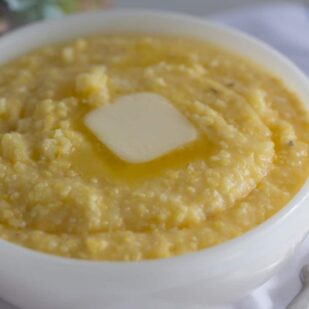
Grits
This is simply coarse ground cornmeal cooked until it is a thick but flowable texture. Perfect for breakfast with butter and maple syrup or for serving alongside pot roast, pork ragu or saucy shrimp dishes.
Ingredients:
- 6 cups (1.4 L) water, lactose-free whole milk, 2%, 1% or fat free
- 1 teaspoon kosher salt, plus extra
- 1 1/2 cups (207 g) coarse ground yellow cornmeal, we prefer stone-ground
- 1/4 cup (½ stick; 57g) unsalted butter, cut into pieces
- Freshly ground black pepper
Preparation:
-
Place liquid and 1 teaspoon salt in a large heavy bottom pot over medium-high heat and bring to a boil. Sprinkle cornmeal in slowly, whisking all the while until it is all added and cornmeal is combined with liquid. Turn heat down to low until the mixture barely simmers and whisk frequently – almost constantly – until mixture is thickened and smooth. As the liquid absorbs and the mixture thickens you will be able to see whisk marks in the grits, but do not overcook. The mixture should remain fluid; you want the mixture to be able to flow from a spoon. Total cooking time will be about 20 to 25 minutes and they should be creamy and tender. Do not rush cooking or the grits will not soften adequately. Add more liquid if necessary if they firm up to quickly.
-
Remove from heat and whisk in butter until incorporated. Taste and season generously with pepper and more salt, if desired.
-
While freshly made grits are the best – they firm up tremendously upon cooling – you can make them up to two hours ahead and reheat them if absolutely necessary. Add a bit of water to the grits and place over low heat. Stir to re-loosen the grits, incorporate with the water and heat until hot all the way through. Serve immediately.
Notes:
Tips
- Grits have a tendency to stick to the pot. A heavy bottomed pot, that conducts heat evenly, is your best bet and if it has rounded corners, you will be able to stay in contact with the grits as you stir and whisk, further eliminating the potential for sticking or burning.
FODMAP Information
All recipes are based upon Monash University & FODMAP Friendly science at time of initial publication.
- Butter: Both Monash University and FODMAP Friendly have lab tested butter. Monash states that a low FODMAP Green Light portion is 1 tablespoon or 19 g and also states that “butter is high in fat and does not contain carbohydrates (FODMAPs)”. FODMAP Friendly gives it a “Pass” at 1 tablespoon or 19 g. Both recommended serving sizes are presented as part of healthy eating guidelines, not as maximum FODMAP serving size. Fat can affect guy motility and trigger IBS symptoms in some people. Eat to your tolerance.
- Cornmeal: Monash University has lab tested cornmeal, which they list as “Polenta (cornmeal)” and a low FODMAP serving size is 255 g, but that is for cooked. They also have a listing for “Flour, corn (masa harina/masa lista)”, and that low FODMAP serving size is 100 g. Masa harina is cornmeal that is treated with lime (calcium hydroxide), a process called nixtamalization. In personal conversations with Monash, we were told that “regular” cornmeal would be the same as the masa, FODMAP-wise, and that the process of using the lime alkaline solution would not affect FODMAPs.
- Lactose-Free Dairy: Lactose-free dairy, such as lactose-free milk or lactose-free cream cheese, has lactase enzyme added that breaks the disaccharide molecules and creates a more digestible dairy product, from a lactose perspective. The resulting product is not dairy-free, but it is lactose-free. Some products might have miniscule amounts of lactose remaining, but the amount is small enough for the product to be labeled as lactose-free. For instance, Breyers Lactose-Free Vanilla Ice Cream states it is 99% lactose-free, while Lactaid Vanilla Ice Cream states it is 100% lactose-free.
Please always refer to the Monash University & FODMAP Friendly smartphone apps for the most up-to-date lab tested information. Foods will be retested from time to time; in the case of raw ingredients, such as fruits and vegetables, results may vary. All lab tested results are valid and represent a snapshot in time. As always, your tolerance is what counts; please eat accordingly. The ultimate goal of the low FODMAP diet is to eat as broadly as possible, without triggering symptoms, for the healthiest microbiome.
Nutrition
All nutritional information is based on third-party calculations and should be considered estimates. Actual nutritional content will vary with brands used, measuring methods, portion sizes and more. For a more detailed explanation, please read our article Understanding The Nutrition Panel Within Our Recipes.
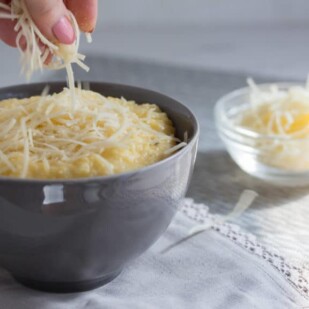
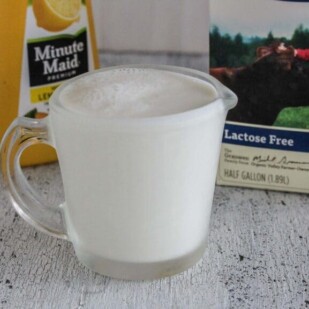



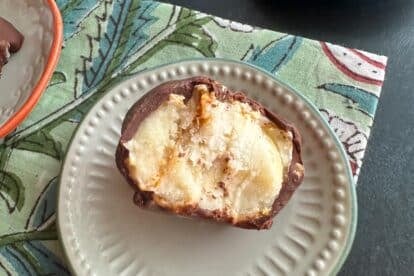

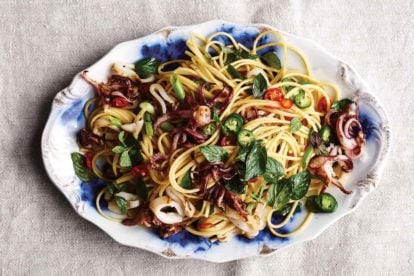
Grits and cornmeal are two different things
Source: I’m originally from the south.
We know that grits are often made from hominy, although not always. The coarse ground cornmeal that we use has been lab tested, while grits made from hominy have not. We can get more specific as more raw ingredients are added by either Monash or FODMAP Friendly. I will take a look at the recipe language to see if I can make things clearer.